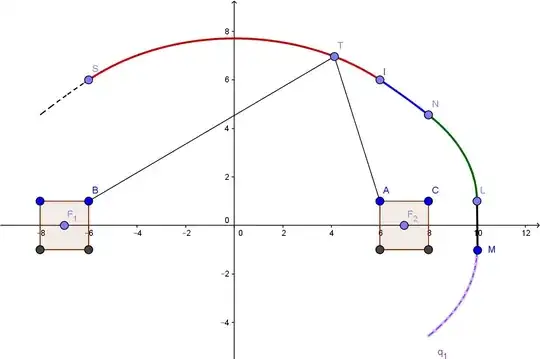Consider the graphical representation below:
It describes a generalized ellipse $(E)$ in the following sense:
$$(E)=\{M \ \ | \ \ d(M,(S_1))+d(M,(S_2))=18 \}$$
where
$(S_1)$ and $(S_2)$, playing a role of "generalized foci", are the squares centered in $F_1(-7,0)$ and $F_2(7,0)$ with sides' length 2,
$d(M,(C))$ is the distance from a point $M$ to a convex set $(C)$ defined by $inf_{C \in (C)} d(M,C)$ where $d(.,.)$ is the usual (Euclidean) distance.
$d(M,(C))$ being a continuous function of $M$ (see for example (Distance to a closed set is continuous.)), generalized ellipse $(E)$ is piecewise continuous.
I would like to show that it is more than that: that it is smooth, in a geometrical sense: (what is called sometimes $\Delta^1$) in each connection point of two arcs (see below) there is a common tangent (as a consequence, it will be possible to define a $C^1$ parameterization).
Question: is there a simple mean to establish this "smoothness" ?
My work: I have established this smoothness explicitly by
first computing the equations of the different constituent arcs of $(E)$.
then for each connecting point (such as $L, N, I$...), by computing the left and right derivative (when it exists) and checking that their values are equal or checking the presence of a vertical tangent.
Due to $Ox$ and $Oy$ symmetries, it suffices to describe the first quadrant part of (E), or, in an equivalent form, the different parts of arc MLNIS. Here are the equations of the constituent arcs:
$$\begin{cases} \text{Arc ML:}\ &\text{line segment:} \ \ & x=10 & -1 \leq y \leq 1\\ \text{Arc LN:}\ &\text{ellipse with foci B and C:} \ \ & \frac{(x-1)^2}{81}+\frac{(y-1)^2}{32}=1& 8 \leq x \leq 10, 1 \leq y \leq \frac{41}{9}\\ \text{Arc NI:}\ &\text{parabola:} \ \ & y=- \frac{1}{36}(x+6)^2+10& 6 \leq x \leq 8, \frac{41}{9} \leq y \leq 6\\ \text{Arc IS:}\ &\text{ellipse with foci B and A:} \ \ & \frac{x^2}{81}+\frac{(y-1)^2}{45}=1& -6 \leq x \leq 6, 6 \leq y \leq 8 \end{cases}$$
But of course, it is very tedious... Moreover I would like to generalize this study to "generalized foci" that could be any polygonal shape, and even any convex curve.
